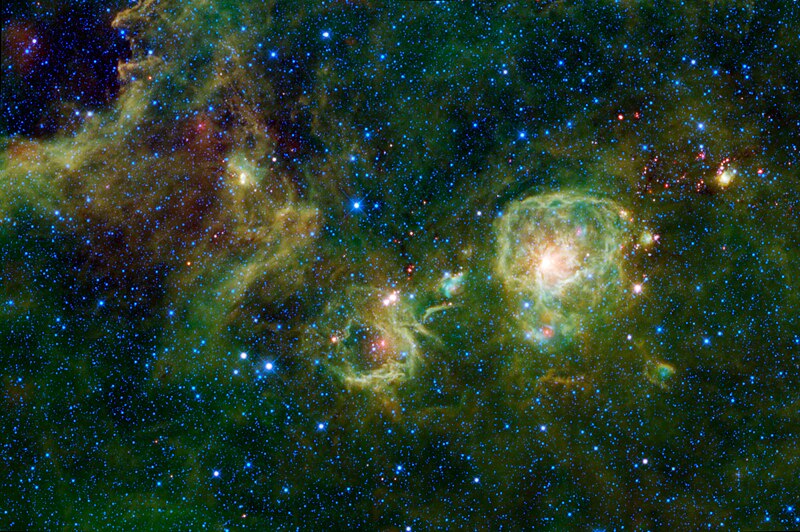File:Vela Molecular Cloud Ridge.jpg

Original file (6,108 × 4,061 pixels, file size: 1.98 MB, MIME type: image/jpeg)
Captions
Captions
Summary[edit]
| DescriptionVela Molecular Cloud Ridge.jpg |
English: New stars are forming inside this giant cloud of dust and gas as seen in infrared light by NASA's Wide-field Infrared Survey Explorer, or WISE. Sprawling across the constellation Vela is a complex of dark, dense clouds of dust and gas, difficult to detect with telescopes that see only visible light. The complex is called the Vela Molecular Cloud Ridge. This ridge may form part of the edge of the Orion spiral arm spur in our Milky Way galaxy. Astronomers mapping out the region in radio light in the late 1980s found four distinct regions of the densest gas and named them clouds A, B, C and D. This image takes in the first of those clouds, Vela A.
Vela A is about 3,300 light-years away. This image of Vela A covers a region on the sky over 4.5 full moons wide and over 3 full moons tall, spanning about 130 light-years in space. The core of the cloud is being excavated by the radiation and winds from hot, young stars. The energy from the new stars is absorbed by the surrounding dust. This hides them from view in visible light, but the heated dust glows in infrared light (seen here in green and red). Sprinkled around Vela A are a few groups of sources that appear very red in this image, and have no known counterparts in visible-light images of the region. It's possible that these may be Young Stellar Objects, which are stars in their very infancy enveloped in dust. The infrared light seen from these baby stars does not come directly from the stars, but rather from the dust around them, which glows as the nascent stars heat it. All four infrared detectors aboard WISE were used to make this mosaic. Color is representational: blue and cyan represent infrared light at wavelengths of 3.4 and 4.6 microns, which is dominated by light from stars. Green and red represent light at 12 and 22 microns, which is mostly light from warm dust. |
| Date | |
| Source | http://www.nasa.gov/mission_pages/WISE/multimedia/gallery/pia13122.html |
| Author | NASA/JPL-Caltech/UCLA |
Licensing[edit]
| Public domainPublic domainfalsefalse |
| This file is in the public domain in the United States because it was solely created by NASA. NASA copyright policy states that "NASA material is not protected by copyright unless noted". (See Template:PD-USGov, NASA copyright policy page or JPL Image Use Policy.) |  | |
 |
Warnings:
|
File history
Click on a date/time to view the file as it appeared at that time.
| Date/Time | Thumbnail | Dimensions | User | Comment | |
|---|---|---|---|---|---|
| current | 18:36, 25 September 2012 |  | 6,108 × 4,061 (1.98 MB) | Stas1995 (talk | contribs) | User created page with UploadWizard |
You cannot overwrite this file.
File usage on Commons
There are no pages that use this file.
File usage on other wikis
The following other wikis use this file:
- Usage on it.wikipedia.org
- Usage on pl.wikipedia.org